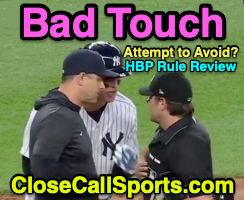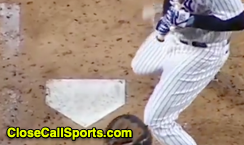Play: With none out and the bases loaded in the top of the 3rd inning, a batter Team Italy, trailing Australia 5-0, hit a high fly ball along the first baseline, on the infield between home plate and first base. The ball fell untouched and was fielded by Australia's first baseman, who threw to the catcher ahead of Italy's runner. The catcher stepped on home plate before throwing to the third baseman, who tagged Italy's lead runner R3 as he ran back toward third base. Having tagged R3, Australia's third baseman then threw to the second baseman, who stepped on second base and then tagged Italy's trailing runner R1 as R1 ran toward second base. Following this, Italy's middle runner R2 took off for third base and Australia's second baseman threw to the third baseman, who tagged R2 as he slid into third base.
Call: The HP Umpire declared an Infield Fly and a fair ball, the 3B Umpire declared R3 out at third base, the 2B Umpire declared R1 out at second base, and then the 3B Umpire declared R2 out at third base.
Correcting the Fourth Out...and More: After the apparent triple play, the umpires conferred and determined that the batted ball had become foul, thus negating all subsequent action. The play was ruled a foul ball, which was confirmed after manager's challenge by Australia, and Italy's batter returned to bat.
Remember, even with all other criteria satisfied (runners on first and second [or bases loaded] with less than two out, batted ball is a fly ball which is not a line drive nor bunt that can be caught be an infielder with ordinary effort), it is only an infield fly if the batted ball is fair [it is not an infield fly if the ball is foul], and the umpire's mechanic should be "Infield Fly, if Fair."
What if (Case Play): Although the ball was foul, let us assume for the purpose of discussion it was fair instead. In that case, the batter would be out for the Infield Fly, R3 would be out on the tag while off-base, and R1 would be out on the tag while off-base (R2's apparent out would be irrelevant and superfluous).
In that sense, the umpires officiated the infield fly portion of this play properly in real-time...the portion of the play that occurred after the first baseman fielded the baseball.
A Confounding Variable, Regardless of Fair/Foul: Replays indicate that while the batted ball was in flight, Australia's first baseman and Italy's baserunner R1 made contact while R1 was not touching first base. In this sense, presuming the umpires would have identified the first baseman F3 as the fielder entitled to field the batted ball pursuant to Official Baseball Rule 6.01(a)(10), R1 should be declared out for interference ("Fails to avoid a fielder who is attempting to field a batted ball...if two or more fielders attempt to field a batted ball and the runner comes in contact with one or more of them, the umpire shall determine which fielder is entitled to the benefit of this rule"). The fielder has the right of way in this situation.
This would then activate the Infield Fly Interference rule (from the definition of terms): "If interference is called during an Infield Fly, the ball remains alive until it is determined whether the ball is fair or foul. If fair, both the runner who interfered with the fielder and the batter are out. If foul, even if caught, the runner is out and the batter returns to bat."
Recap: If the umpires protect the pitcher as the fielder entitled to field the ball, foul ball is the correct call.
However, if the umpires identified the first baseman as the fielder entitled to field the ball, the proper call would have been a foul ball, but with the additional declaration that the runner from first base R1 is out for interference.
Under the Case Play scenario wherein the batted ball is fielded in fair territory and the pitcher is the protected fielder, this is a triple play (batter-runner out on the infield fly, R3 out on tag, R1 out on tag).
Under the Case Play scenario wherein the batted ball is fielded in fair territory and the first baseman is the protected fielder, this is a double play (R1 out on interference & batter-runner out on the infield fly).
Video as follows:
Video as follows:
































